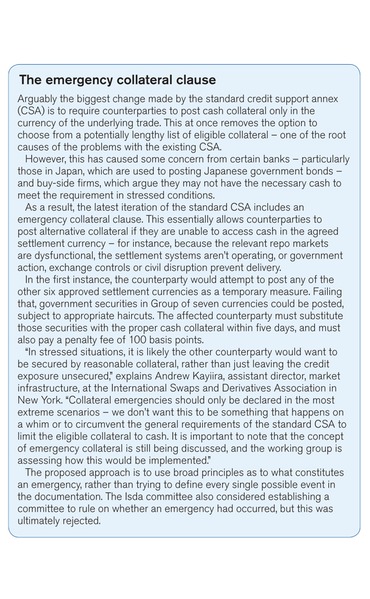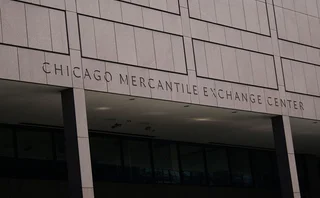
Cutting complexity with a new standard CSA
 The 17-silo proposal
The 17-silo proposal
This is a significant change from earlier proposals, which included just five silos, corresponding to those currencies with liquid OIS curves: dollar, euro, yen, sterling and Swiss franc. Expanding the number of silos means alternative discount rates will need to be agreed for silos six to 17, at least until liquid OIS curves develop in those markets.
That means it may not be as theoretically ‘pure’ as the five-silo proposal – but this approach is already employed by LCH.Clearnet for its SwapClear interest rate swap clearing service, and dealers are keen to ensure the methodologies for cleared and uncleared trades mirror each other, eliminating any mismatch that might occur between a bilateral transaction under the standard CSA and a cleared hedge.
“One of the overarching goals of this process is to allow for an ease of transfer and harmonisation between the cleared and uncleared market, so this is an example of us being aware of what is happening in the cleared market and moving towards that,” says Andrew Kayiira, assistant director, market infrastructure, at Isda in New York.
Any mismatch could have been problematic, say participants. Under earlier proposals, a Norwegian krone trade might have been allocated to the euro silo under the standard CSA, requiring collateral to be posted in euro cash and Eonia to be used to discount the transaction. However, it is likely a hedge conducted with an interdealer counterparty would be cleared through LCH.Clearnet, requiring Norwegian krone cash to be posted as collateral, with a local Norwegian krone Libor-style curve used to discount the trade.
“Aligning the core variation margin structure across cleared and bilateral hemispheres of the market makes risk management sense. If you were not using the Group of 17 (G-17) currency silos in the bilateral context, your Norwegian krone swap with the client would be collateralised in, say, euro, but a hedge cleared through LCH.Clearnet would require Norwegian krone collateral to be delivered, so there’s cross-gamma risk there. Having greater alignment also makes it easier to transfer risk to clearing houses,” says Michael Clarke, a managing director at Goldman Sachs, and co-chair of the Isda collateral steering committee.
Another reason for the expansion is to avert potential problems down the line as new silos are added. For example, if Australian dollar trades were allocated to the US dollar silo initially, but liquidity in the local OIS curve quickly improved and an Australian dollar silo was added after one year, it is unclear what would happen to the US dollar-siloed trades. Moving them to the new Australian dollar silo would have an economic impact, because the discount rate would change from federal funds to Australian dollar OIS. However, keeping them in the existing silo would create operational complexity: it would leave banks having to simultaneously manage Australian dollar trades under the old CSA, new CSA trades allocated to the US dollar bucket, and new CSA trades allocated to the Australian dollar silo.
“People were concerned about adding silos later on. If you start with five, what happens when you need nine or 10? It gets quite messy. So the view was, why don’t we just go for 17 straight away and simplify that part of the equation? The downside is you have to use proxy OIS rates for the G-6 to G-17 currencies, but we already do that in LCH.Clearnet,” says Clarke. It is likely the same proxy rates would be used to discount both cleared and uncleared trades – although this has not been confirmed. Ultimately, it is hoped starting with the extra silos will spur development of OIS curves in those markets.
While the 17 LCH.Clearnet currencies would be allocated to their own silos, those falling outside that universe would be allocated either to the US dollar or euro buckets, according to a mapping table based on analysis of the historical correlations of currencies. In the event a new silo is created, deleted or combined, counterparties will need to adhere to a silo restructuring protocol, which will outline a standard treatment for all affected trades.
Essentially, when a new silo is added, all pre-existing trades will remain in their former silo unless each set of parties bilaterally agrees to switch them over – therefore avoiding the economic impact that could occur from a mandatory change in collateral terms. All new trades would be allocated to the new silo. If a currency is merged with another – for instance, if Denmark chooses to join the euro – then all the trades in the deleted silo would be switched over. Where a currency ceases to exist, the trades would be re-allocated to the silo that had the closest correlation to the deleted currency. “These are the kinds of things you need to clarify – and you want to clarify them now,” says Feil at Deutsche Bank.

Only users who have a paid subscription or are part of a corporate subscription are able to print or copy content.
To access these options, along with all other subscription benefits, please contact info@risk.net or view our subscription options here: http://subscriptions.risk.net/subscribe
You are currently unable to print this content. Please contact info@risk.net to find out more.
You are currently unable to copy this content. Please contact info@risk.net to find out more.
Copyright Infopro Digital Limited. All rights reserved.
As outlined in our terms and conditions, https://www.infopro-digital.com/terms-and-conditions/subscriptions/ (point 2.4), printing is limited to a single copy.
If you would like to purchase additional rights please email info@risk.net
Copyright Infopro Digital Limited. All rights reserved.
You may share this content using our article tools. As outlined in our terms and conditions, https://www.infopro-digital.com/terms-and-conditions/subscriptions/ (clause 2.4), an Authorised User may only make one copy of the materials for their own personal use. You must also comply with the restrictions in clause 2.5.
If you would like to purchase additional rights please email info@risk.net
More on Interest rate markets
New benchmark to give Philippine peso swaps a fillip, post-Isda add
Isda to include new PHP overnight rate and Indonesia’s Indonia in its next definitions update
SABR convexity adjustment for an arithmetic average RFR swap
A model-independent convexity adjustment for interest rate swaps is introduced
NatWest Securities US Treasury trading head departs
Jason Sable joined the UK bank in January 2022 from BNP Paribas
CME in talks to clear term SOFR basis swaps
US clearing house has held discussions with some dealers about clearing term SOFR-SOFR packages
Risky caplet pricing with backward-looking rates
The Hull-White model for short rates is extended to include compounded rates and credit risk
The curious case of backward short rates
A discretisation approach for both backward- and forward-looking interest rate derivatives is proposed
Cross-currency swaps will use RFRs on both legs, says JP exec
Despite slow start, all-RFR swaps will become the market standard within a year, according to Tom Prickett
June mid-month auctions – Coupon and yield trends
As Treasury issuance amounts set new records, coupons at the front end of the curve have marched downward, while back-end coupons have lagged. Yield spreads across each popular measure show a consistent steepening of the curve through the first half of…







